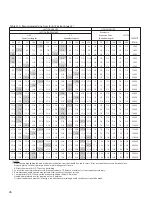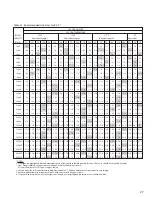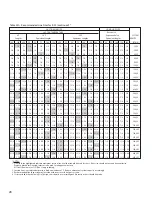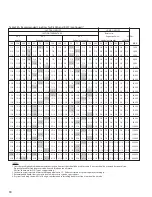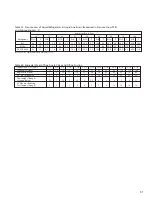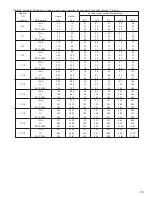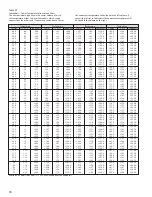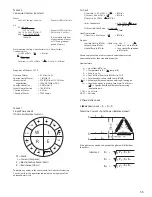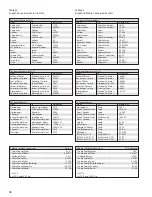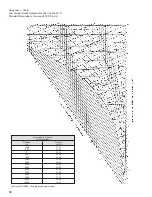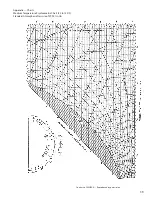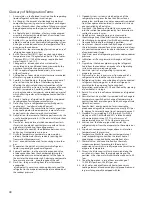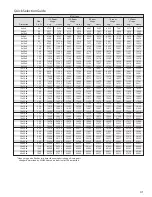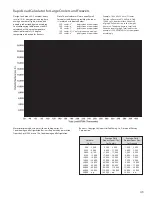
40
Glossary of Refrigeration Terms
1. Accumulator - a shell placed in suction line for separating
liquid refrigerant entrained in suction gas.
2. Air Changes - the amount of air leakage is sometimes
computed by assuming a certain number of air changers
per hour for each room, the number of changes assumed
being dependent upon the type, use and location of the
room.
3. Air Cooler, Forced Circulation - a factory-made encased
assembly of elements by which heat is transferred from
air to evaporating refrigerant.
4. Ambient Air - generally speaking, the air surrounding an
object. In a domestic or commercial refrigerating system
having an air-cooled condenser, the temperature of the
air entering the condenser.
5. Back Pressure - loose terminology for suction pressure of
refrigeration vapor in a system.
6. British Thermal Unit (BTU) - heat required to produce a
temperature rise of 1 degree Fahrenheit in 1 lb. of water.
The mean BTU is 1/180 of the energy required to heat
water from 32ºF. to 212ºF.
7. Change of Air - introduction of new, cleansed or
recirculated air to conditioned space, measured by the
number of complete changes per unit time.
8. Chill - to apply refrigeration moderately, as to meats,
without freezing.
9. Chilling Room - room where animal carcasses are cooled
after dressing prior to cold storage.
10. Comfort Air Conditioning - the simultaneous control of
all, or at least the first three, of the following factors
affecting the physical and chemical conditions of the
atmosphere within a structure for the purpose of human
comfort; temperature, humidity, motion, distribution,
dust, bacteria, odors, toxic gasses and ionization, most of
which affect in greater or lesser degree human health or
comfort.
11. Comfort Cooling - refrigeration for comfort as opposed
to refrigeration for storage or manufacture.
12. Defrosting Cycle - a refrigeration cycle which permits
cooling unit to defrost during off period.
13. Dehumidification - the conservation of water vapor from
air by cooling below the dew point or removal of water
vapor from air by chemical or physical methods.
14. Dehydration - the removal of water vapor from air by the
use of absorbing materials. (2) The removal of water from
stored goods.
15. Dew Point - temperature at which condensation starts
if moist air is cooled at constant pressure with no loss or
gain of moisture during the cooling process.
16. Differential (of a control) - the difference between cut-in
and cut-out temperature or pressure.
17. Dry Bulb Temperature - temperature measured by
ordinary thermometer (term used only to distinguish
from wet-bulb temperature).
18. Duct - a conduit or tube used for conveying air or other
gas.
19. Evaporator - the part of a system in which refrigerant
liquid is vaporizing to produce refrigerant.
20. External Equalizer - in a thermostatic expansion valve,
a tube connection from the chamber containing the
evaporation pressure-actuated element of the valve to
the outlet or the evaporator coil. A device to compensate
for excessive pressure drop throughout the coil.
21. Flash Gas - the gas resulting from the instantaneous
evaporation
of refrigerant in a pressure-reducing device to cool the
refrigerant to the evaporations temperature obtained at
the reduces pressure.
22. Flooded System - system in which only part of the
refrigerant passing over the heat transfer surface is
evaporated, and the portion not evaporated is separated
from the vapor and recirculated. In commercial systems,
one controlled by a float valve.
23. Frost Back - the flooding of liquid from an evaporator
into the suction line accompanied by frost formation in
suction line in most cases.
24. Head Pressure - operating pressure measured in
thedischarge line at the outlet from the compressor.
25. Heat Exchanger - apparatus in which heat is exchanged
from one fluid to another through a partition.
26. Heat, Latent - heat characterized by change of state of
the substance concerned, for a given pressure and always
at a constant temperature for a pure substance, i.e., heat
of vaporization or fusion.
27. High Side - parts of refrigerating system under condenser
pressure.
28. Infiltration - air flowing inward as through a wall, leak,
etc.
29. Liquid Line - the tube or pipe carrying the refrigerant
liquid from the condenser or receiver of a refrigerating
system to a pressure-reducing device.
30. Low Side - parts of a refrigerating system under
evaporator pressure.
31. Pressure Drop - loss in pressure, as from one end of a
refrigerant line to the other, due to friction, etc.
32. Refrigerating System - a combination of inter-connected
refrigerant-containing parts in which a refrigerant is
circulated for the purpose of extracting heat.
33. Respiration - production of CO2 and the heat by ripening
of perishables in storage.
34. Return Air - air returned from conditioned or refrigerated
space.
35. Sensible Heat - heat which is associated with a change in
temperature; specific heat x change of temperature; in
contrast to a heat interchange in which a change of state
(latent heat) occurs.
36. Specific Heat - energy per unit of mass required to
produce one degree rise in temperature, usually BTU per
lb. degree F. numerically equal to cal. per gram degree C.
37. Standard Air - air weighing 0.075 lb. per cu. ft. which is
closely air at 68ºF. dry bulb and 50% relative humidity
at barometric pressure of 29.92 in. of mercury of
approximately dry air at 70ºF. at the same pressure.
38. Suction line - the tube or pipe which carries the
refrigerant vapor from the evaporator to the compressor
inlet.
39. Superheat - temperature of vapor above its saturation
temperature at that pressure.
40. Temperature, Wet-Bulb - equilibrium temperature of
water evaporating into air when the latent heat of
vaporization is supplied by the sensible heat of air.
41. Thermal Valve - a valve controlled by a thermally
responsive element, for example, a thermostatic
expansion valve which is usually responsive to suction or
evaporator temperature.
42. Throw - the distance air will carry, measured along the
axis of an air stream from the supply opening to the
position, is the stream at which air motion reduces to 50
fpm.
43. Ton of Refrigeration - a rate of heat interchange of
12,000 BTU per hour; 200 BTU per min.
44. Unit Cooler - adapted from unit heater to cover any
cooling element of condensed physical proportions and
large surface generally equipped with fan.

